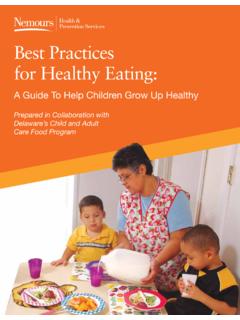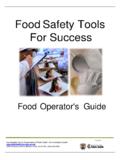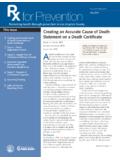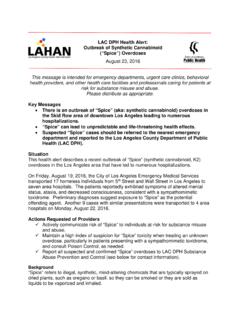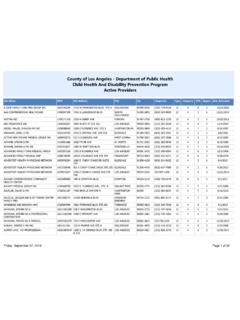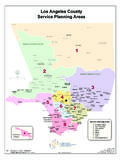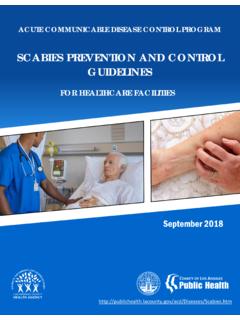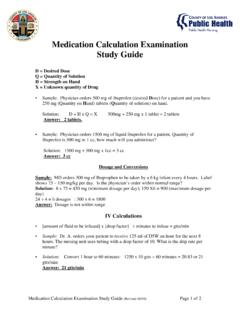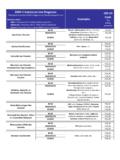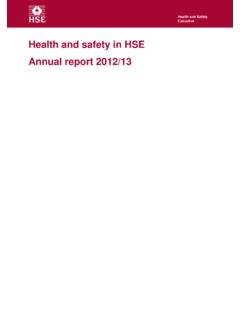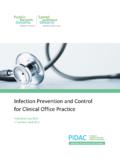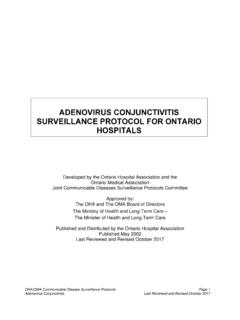Transcription of Regulations for Communicable Disease Reporting
1 Regulations FOR Communicable . Disease Reporting . Admissions and Infection Control in Hospitals and Healthcare Organizations Robert Kim-Farley, MD, MPH. Director, Disease Control Programs COUNTY OF LOS ANGELES - DEPARTMENT OF PUBLIC HEALTH. Acute Communicable Disease Control 313 North Figueroa Street Los Angeles, CA 90012. B-82 (revised 02/00). TABLE OF CONTENTS. Page PART I: reportable DISEASES .. 1. A. Who Should Report .. 2. B. Diseases Required To Be Reported By Laboratories .. 2. C. Telephone Reporting .. 2. D. Reporting Of Outbreaks .. 3. E. Occurrence Of Unusual Diseases .. 3. F. Special Investigations .. 3. G. Why Report .. 3. H. Disease Reporting .. 4. PART II: Communicable Disease CONTROL Regulations FOR HEALTHCARE.
2 ORGANIZATIONS. Introduction .. 5. Section 1: Diseases in Healthcare Facilities Requiring Special Restrictions .. 5. Section 2: Transfer or Discharge of Patients With Communicable Diseases from Healthcare Facilities .. 6. Section 3: Regulations Regarding Communicable Diseases in Skilled Nursing Facilities .. 6. Section 4: Regulations Regarding Communicable Diseases in Intermediate Care Facilities .. 7. Section 5: Infection Control and Employee Health Policies in Healthcare Facilities and Home Health Agencies .. 7. Section 6: References .. 8. PART I: reportable DISEASES. Communicable DISEASES (CCR 2500) Relapsing FeverU. Acquired Immune Deficiency Syndrome (AIDS) Reye Syndrome AmebiasisU Rheumatic Fever, Acute AnisakiasisU Rocky Mountain Spotted Fever Anthrax!
3 Rubella (German Measles). BabesiosisU Rubella Syndrome, Congenital Botulism (Infant, Foodborne, Wound)! Salmonellosis (other than Typhoid Fever)U. Brucellosis Scabies (Atypical or Crusted)*! CampylobacteriosisU Scombroid Fish Poisoning! Chancroid ShigellosisU. Chlamydial Infections Streptococcal Infections (Outbreaks of any Type and Cholera! Individual Cases in Food Handlers and Dairy Workers Ciguatera Fish Poisoning! Only)U; Invasive Group A Streptococcal Infections Coccidioidomycosis including Streptococcal Toxic Shock Syndrome and Colorado Tick FeverU Necrotizing Fasciitis*U (Do not report individual cases of Conjunctivitis, Acute Infectious of the Newborn, Specify pharyngitis or scarlet fever.)
4 EtiologyU Swimmer's Itch (Schistosomal Dermatitis)U. CryptosporidiosisU SyphilisU. Cysticercosis Tetanus Dengue! Toxic Shock Syndrome Diarrhea of the Newborn, Outbreaks! Toxoplasmosis Diphtheria! TrichinosisU. Domoic Acid Poisoning (Amnesic Shellfish Poisoning)! Tuberculosis (report immediately by phone or fax)U. Echinococcosis (Hydatid Disease ) Tularemia Ehrlichiosis Typhoid Fever, Cases and CarriersU. Encephalitis, Specify Etiology: Viral, Bacterial, Fungal, Typhus Fever ParasiticU Vibrio InfectionsU. Escherichia coli O157:H7 Infection! Viral Hemorrhagic Fevers ( , Crimean-Congo, Ebola, Foodborne Disease U Lassa, and Marburg viruses)! Giardiasis Water-associated DiseaseU. Gonococcal Infections Yellow Fever!
5 Haemophilus influenzae, Invasive DiseaseU YersiniosisU. Hantavirus Infections! OCCURRENCE OF ANY UNUSUAL Disease ! Hemolytic Uremic Syndrome! OUTBREAKS OF ANY Disease ! Hepatitis, Viral Hepatitis AU Notification Required of Laboratories (CCR 2505). Hepatitis B (Specify Acute Case or Chronic) Chlamydial infections Hepatitis C (Specify Acute Case or Chronic) CryptosporidiosisU. Hepatitis D (Delta) Diphtheria! Hepatitis, Other, Acute Encephalitis, arboviralU. Kawasaki Syndrome (Mucocutaneous Lymph Node Escherichia coli O157:H7 or Shiga toxin-producing E. coli Syndrome) O157:NM!>. Legionellosis Gonorrhea Leprosy (Hansen Disease ) Hepatitis A, acute infection, by IgM antibody test or positive Leptospirosis viral antigen testU.
6 ListeriosisU Hepatitis B, acute infection, by IgM anti-HBc antibody test Lyme Disease Hepatitis B surface antigen positivity (specify gender). Lymphocytic ChoriomeningitisU ListeriosisU>. MalariaU MalariaU>. Measles (Rubeola)U Measles (Rubeola), acute infection, by IgM antibody test or Meningitis, Specify Etiology: Viral, Bacterial, Fungal, positive viral antigen testU. ParasiticU Plague, animal or human! Meningococcal Infections! Rabies, animal or human! Mumps SyphilisU. Non-Gonococcal Urethritis (report laboratory-confirmed TuberculosisU>. chlamydial infections as chlamydia) Typhoid and other Salmonella isolatesU> (CCR 2612). Paralytic Shellfish Poisoning! Vibrio species infectionsU>.
7 Pelvic Inflammatory Disease (PID). Pertussis (Whooping Cough)U NON- Communicable DISEASES OR CONDITIONS. Plague, Human or Animal! Alzheimer's Disease and Related Conditions Poliomyelitis, ParalyticU Disorders Characterized by Lapses of Consciousness PsittacosisU Pesticide-Related Illnesses (Health & Safety Code, Q FeverU 105200)! Rabies, Human or Animal! ! Report immediately by telephone. U Report by mailing, telephoning or electronically transmitting a report within one (1) working day of identification of the case or suspected case. When two (2) or more cases or suspected cases of foodborne Disease from separate households are suspected to have the same source of illness, they should be reported immediately by telephone.
8 No symbols: Report within seven (7) calendar days from the time of identification by mail, telephone, or electronic report. * reportable to Los Angeles County Department of Health Services. > Bacterial isolates and malarial slides must be forwarded to the DHS Public Health Laboratory for confirmation. Health-care providers must still report all such cases separately. 1. A. WHO SHOULD REPORT. Medical doctors, osteopaths, veterinarians, podiatrists, nurse practitioners, physician assistants, registered nurses, nurse midwives, infection control practitioners, medical examiners, coroners, dentists, and administrators of health facilities and clinics knowing of a case or suspected case of a Communicable Disease are required to report it to the local health department (Section 2500).
9 In addition, anyone in charge of a public or private school, kindergarten, boarding school, or preschool also is required to report these diseases (Section 2508). B. DISEASES REQUIRED TO BE REPORTED BY LABORATORIES (California Code of Regulations , Title 17, Section 2505, Public Health, 1996). Chlamydial infections Cryptosporidiosis Diphtheria Encephalitis, arboviral Escherichia coli O157:H7 or Shiga toxin-producing E. coli O157:NM. Gonorrhea Hepatitis A, acute infection, by IgM antibody test or positive viral antigen test Hepatitis B, acute infection, by IgM anti-HBc antibody test Hepatitis B surface antigen positivity (specify gender). Listeriosis Malaria Measles (Rubeola), acute infection, by IgM antibody test or positive viral antigen test Plague, animal or human Rabies, animal or human Syphilis Tuberculosis Typhoid Vibrio species infections C.
10 TELEPHONE Reporting . The following diseases require immediate telephone report to the local health officer during working hours. After working hours, on weekends, or holidays, the medical Administrative Officer of the Day (AOD) may be reached through the County Operator at (213) 974-1234. Follow with a written report of the confirmed diagnosis on the Confidential Morbidity Report (CMR) form within 24 hours. Anthrax Meningococcal infection Botulism Plague, human or animal Cholera Rabies, human or animal Dengue Scabies (atypical or crusted). Diarrhea of the newborn, outbreaks Viral Hemorrhagic Fevers ( ,Crimean- Diphtheria Congo, Ebola, Lassa, Marburg viruses). Escherichia coli O157:H7 infection Yellow Fever Foodborne illness* Occurrence of Any Unusual Disease Hantavirus infections Outbreaks of Any Disease Hemolytic uremic syndrome _____.
